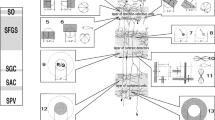Summary
The morphology of amacrine cells in the retina of the carp is described using the Golgi technique. The ramification pattern of these cells was analyzed in flat-mounts of retinas. Based on these observations classification into five groups was made. Cells possessing one principal process leaving the soma were subdivided into starburst A-neurons and radiate neurons. Cells having two or more principal processes were subdivided into starburst B-neurons and spindle-shaped soma neurons. Small, diffuse amacrine cells form the fifth group. With respect to the shape of the field of arborization, the following cell types could be distinguished: (i) uniform cells, (ii) cells with a preferential direction, and (iii) cells with a marked edge, i.e., cells that lack processes in one direction. The latter form rarely occurs among starburst neurons; most of the spindle-shaped soma cells possess processes with a preferred direction, and cells with a marked edge are mainly found among the radiate neurons.
All five cell types are found throughout the retina. The size of the cells varies within each group, and there is no correlation between size and distance from the optic nerve.
The radial arborization pattern of each cell was examined in serial transverse sections. Starburst A-neurons ramify in the middle of the inner plexiform layer (IPL), radiate neurons in the inner half, and spindle-shaped soma neurons without overlapping processes (type B) as well as starburst B-neurons in the outer half. The ramification can be monostratified (narrow or broad), bistratified or multistratified. Small, diffuse amacrine cells and spindle-shaped soma neurons with overlapping processes (type A) ramify throughout the entire IPL.
Similar content being viewed by others
References
Boycott BB, Dowling JE (1969) Organisation of the primate retina: Light microscopy. Phil Trans R Soc (London) 255:109–184
Boycott BB, Wässle H (1974) The morphological types of ganglion cells of the domestic cat's retina. J Physiol 240:397–419
Cajal S, Ramón Y (1893) La rétine des Vertébrés. Cellule 9:119–225
Chan RZ, Naka KI (1976) The amacrine cell. Vision Res 16:1119–1129
Dowling JE (1970) Organisation of vertebrate retinas. Invest Ophthal 9:655–680
Dowling JE, Boycott BB (1965) Neural connections of the retina: Fine structure of the inner plexiform layer. Cold Spring Harbor Symp Quant Biol 30:393–402
Dowling JE, Boycott BB (1966) Organisation of the primate retina: electron microscopy. Proc R Soc London Ser B 166:80–111
Dubin MW (1970) The inner plexiform layer of the vertebrate retina. J Comp Neurol 140:479–506
Famiglietti EV Jr, Kaneko A, Tachibana M (1977) Neuronal architecture of ON and OFF pathways to ganglion cells in carp retina. Science 198:1267–1269
Glickman RD, Adolph AR, Dowling JE (1980) Does Substance P have a physiological role in the carp retina? Invest Ophth Vis Sci (Suppl) 19:281
Karten HJ, Brecha N (1980) Localisation of Substance P immunoreactivity in amacrine cells of the retina. Nature (Lond) 283:87–88
Marc RE, Lam DMK, Stell WK (1979) Glycinergic pathways in the goldfish retina. Invest Ophth Vis Sci (Suppl.) 18
Marchiafava PL (1979) The responses of retinal ganglion cells to stationary and moving visual stimuli. Vision Res 19:1203–1211
Marchiafava PL, Torre V (1978) The responses of amacrine cells to light and intracellularly applied currents. J Physiol 276:83–102
Marchiafava PL, Weiler R (1980) Intracellular analysis and structural correlates of the organisation of inputs to ganglion cells in the retina of the turtle. Proc R Soc London Ser B 208; 103–113
Murakami M, Shimoda Y (1977) Identification of amacrine and ganglion cells in the carp retina. J Physiol 264:801–818
Naka KI (1980) A class of catfish amacrine cells responds preferentially to objects which move vertically. Vision Res 20:961–966
Naka KI, Carraway NRG (1975) Morphological and functional identification of catfish retinal neurons. I. Classical morphology. J Neurophysiol 38:53–71
Naka KI, Ohtsuka T (1975) Morphological and functional identification of catfish retinal neurons. II. Morphological identification. J Neurophysiol 38:72–91
Nelson R, Famiglietti EV Jr, Kolb H (1978) Intracellular staining reveals different levels of stratification for on- and off-center ganglion cells in cat retina. J Neurophysiol 41:472–483
Perry VH, Walker M (1980) Amacrine cells, displaced amacrine cells and interplexiform cells in the retina of the rat. Proc R Soc London 208:415–431
Peterson EH, Ulinski PS (1979) Quantitative studies of retinal ganglion cells in a turtle, Pseudemys scripta elegans I. Number and distribution of ganglion cell. J Comp Neurol 186:17–47
Ramon-Moliner E (1962) An attempt at classifying nerve cells on the basis of their dendritic patterns. J Comp Neurol 119:211–227
Tachibana M (1978) Displaced ganglion cells in carp retina revealed by the horseradish peroxidase technique. Neuroscience letters 9:153–157
Wagner HJ (1973) Die nervösen Netzhautelemente von Nannacara anomala (Cichlidae, Teleostei). I. Darstellung durch Silberimprägnation. Z Zellforsch 137:63–86
Weiler R (1978) Horizontal cells of the carp retina: Golgi impregnation and Procion Yellow injection. Cell Tissue Res 195:515–526
Weiler R, Marchiafava PL (1981) Photoresponses and morphology of amacrine cells in the turtle retina. Invest Ophth Vis Sci (Suppl) 20:183
Werblin FS (1972) Lateral interactions at inner plexiform layer of vertebrate retina: antagonistic responses to change. Science 175:1008
Werblin FS (1977) Regenerative amacrine cell depolarisation and formation of on-off ganglion cell response. J Physiol 264:767–785
Witkovsky P, Dowling JE (1969) Synaptic relationship in the plexiform layers of the carp retina. Z Zellforsch 100:60–82
Witkovsky P, Stell WK (1973) Retinal structure in the smooth dogfish Mustelus canis: Electron microscopy of serially sectioned bipolar cell synaptic terminals. J Comp Neur 150:147–168
Author information
Authors and Affiliations
Additional information
This work was supported by the Deutsche Forschungsgemeinschaft
Rights and permissions
About this article
Cite this article
Ammermüller, J., Weiler, R. The ramification pattern of amacrine cells within the inner plexiform layer of the carp retina. Cell Tissue Res. 220, 699–723 (1981). https://doi.org/10.1007/BF00210456
Accepted:
Issue Date:
DOI: https://doi.org/10.1007/BF00210456




